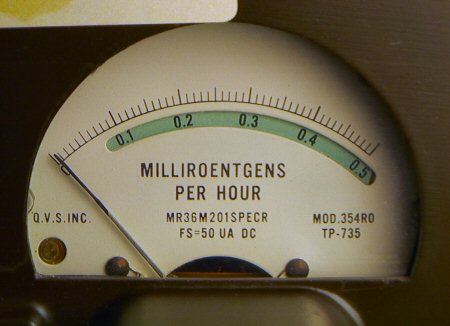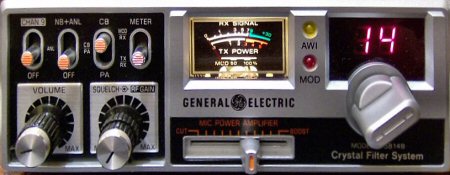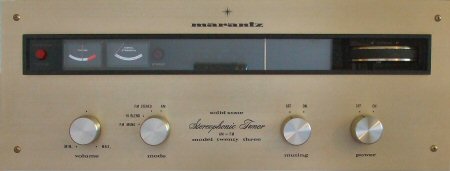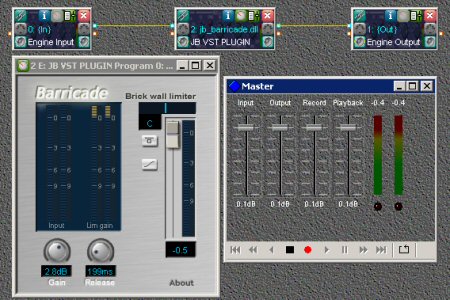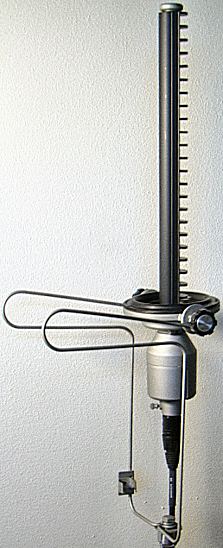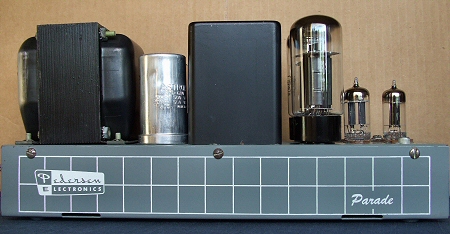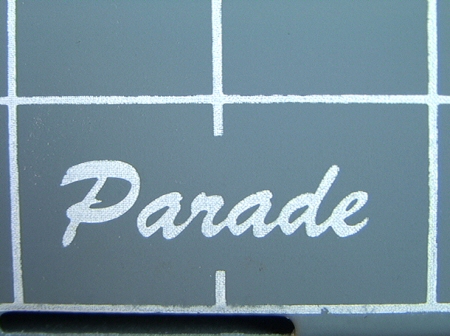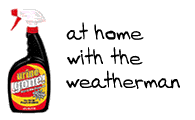
This was sometime in the late 1960s at my home in Martinez, California. I recognize a Knight Kit KM-15 monaural amplifier at the lower right.


My First Hi-Fi
My Geiger Counter
Direct mp4 download or play: My Geiger Counter
This is a recording of my Geiger counter in Seattle, Washington on the afternoon of December 8th, 2011, for a little more than five minutes. The recording time was from approximately 4:38 PM to 4:43 PM. The sensor was just lying on my dining room table and pointing in a northerly direction, and the sensitivity was set at maximum. I purchased this unit from a little electronics surplus shop in Pacheco, California called “The Odd Assortment.” Be sure to take a look at my YouTube version here.
Here is the Geiger counter showing the sensor on the right, and the headphone jack on the left. The audio is going to the red wire, and then to my audio mixer. I don’t understand why a BNC connector was used instead of a standard quarter inch jack for the headphones. As far as I know, atomic or nuclear radiation is not electromagnetic, and does not produce radio waves which could interfere with the headphones. BNC connectors are used on radio transceivers where shielding of electromagnetic energy is important.
This shows the Geiger counter was calibrated, and the unit appeared to be new and unused.
If I’m looking at the meter correctly, the reading went no higher than .02 on the video. That appears to be extremely low. I don’t know if the meter retained its calibration, and I have no way of knowing if the unit is actually functioning correctly. In addition, I don’t think I own anything that is known to be radioactive. Any thoughts?
Radio Sounds Mix: Shortwave, CB, Scanner, AM – Early 1980s
Here is a recording featuring multiple radio receivers. The shortwave sounds were received on my Regency WT-4 multiband tube radio. The Citizens Band (CB) sounds were received on my General Electric 3-5814 CB transceiver. The scanner radio was most likely my Bearcat 300. The AM radio sounds (mostly KGO, San Francisco) were probably from a stereo component tuner, possibly a Marantz Model 23. The ham radio jammers on 146.82 mhz were up to their usual hijinks by playing tape loops “pull your pants down” and “knock that stuff off” etc. and then they start talking about Jesus Christ. The person singing on CB was another highlight. I recorded this onto my Superscope C-104 monaural cassette recorder sometime in the early 1980s at my home in Martinez, California.
I can’t remember how I mixed the audio, but I may have used a passive (potentiometers and resistors) home-brew line level mixer. Capturing the audio was done by playing the cassette on my Sony TC-D5M (Dolby NR off) connected to my Yamaha MG10/2 mixer and then to my PC running Windows 7 Home Edition with a Creative Audigy 4 Pro soundcard. I used VST Host (see bottom picture) to create a .wav file and Adobe Audition to slightly adjust and edit the audio. Then I picked a single (left or right) channel and saved it as a monaural .wav file. Lastly, the monaural .wav file was changed to a monaural mp3 at 128kbps using the LAME encoder and RazorLame.

Regency WT-4 Multiband Tube Receiver
General Electric 3-5814 CB Transceiver
Marantz Model 23 Tuner
Bearcat BC300 Scanner
This is the VST capture setup showing the input on the limiter set to plus 2.8 db, to more closely match the output of the Yamaha mixer and the peak limiter was set to minus .5db. The master levels are all set to plus .1 db only because after moving the level off of zero db they would not set back to zero, using the mouse. As you can see, peak levels of minus .4db were reached, which is exactly .1 db different from the limiter. I doubt if I could have been that precise with any analog setup. I will say that analog sound probably has better fidelity, in the long run. But remember, that is a matter of opinion.
H.H. Scott A426 Amplifier
Now with Schematic and Specifications
Click HERE for a high resolution schematic diagram and HERE for the specifications. Unfortunately the schematic is so small, a lot of the values of the components are unreadable. It does actually look this way in the instruction booklet. The specifications page is quite clear. More information about this amplifier was requested and I hope this helps.
This was purchased in the early 1970’s by a friend in the San Francisco Bay Area. In the late 70’s or early 80’s my friend sold it to me and I used it in my audio system until 2002. When I moved from California to Seattle in the fall of 2002, I packed the amplifier in its original box. It stayed untouched in my garage until late 2007, when I unpacked it and started using it again. This is the amplifier I’m referring to in the post “075” on this site and it does still work perfectly. I can remember when I was in Cal Hi Fi,a stereo hifi shop in Pleasant Hill, California, where these and similar stereo amplifiers were sold. The sales person referred to this as a “sexy” amplifier.


A426 schematic diagram (go to top of page to view or download high resolution image)
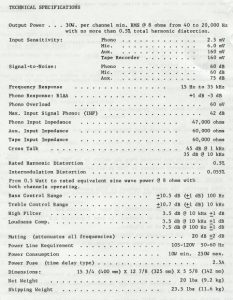
A426 specifications (go to top of page to view or download high resolution image)
JBL 2402H-05 Bullet Tweeter
Direct mp4 download or play: JBL 2402H-05 Bullet Tweeter
This is how this speaker works as a microphone. I simply connected it to a microphone input on my mixer (with the phantom power off) and set the input gain to maximum. I’m surprised at how much it still sounds like a tweeter, even when operating as a microphone. I expected it to have more bass response, considering the diaphragm is 1 and ¾ inches in diameter. You may also notice the recording picked up a radio station in the background. This was probably due to the lack of shielding, and the speaker was never meant to be used as a microphone.
JBL model 2402H-05 Bullet Tweeter
JBL model 2402H-05 Backside
Newcomb TR-1625M
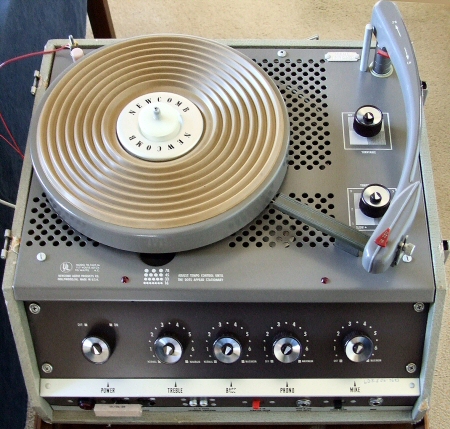

This is the record player I used to record all of the 78 rpm records I have presented up to this point, including “Dreamo Sleeping Pills.” Newcomb is the brand name of a record player schools had throughout the 1960s.
Electro-Voice DL-42
______________________________________
Here are two slightly different views of my Electro-Voice DL-42 shotgun dynamic microphone. I think this model was manufactured in the 1970s. It is similar in appearance to the older 642 which won an Academy Award in 1963 for technical achievement.
Dynaco Mark III (updated)
I bought this as a kit from a little hi-fi shop in Berkeley, California for $79.95 and built it myself in the early 1970s.
075


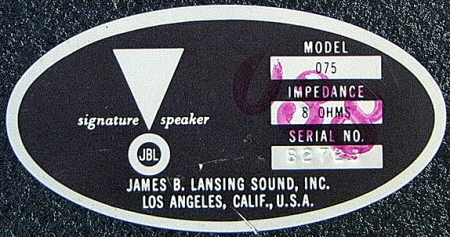
This is one of four I purchased on eBay. As far as I can tell, units like these were manufactured as early as 1956 and I’m guessing all of mine are considerably newer. The DC resistance measures 6.5 ohms and the impedance is 8 ohms. The others all have very similar DC resistance ( 6 to 7 ohms) and are 8 ohm impedance. If you look closely around the edge, you’ll see a Philips head screw and three dark red circles. The red circles are the highly coveted JBL wax seals. If you can find an 075 with all four seals in place I understand they become considerably more collectable. All of mine sound great, and I’m using two at the present time.
One thing I’m not good at is determining the proper value of conponents for a crossover network. I do know that inserting a capacitor in series between an amplifier and a speaker will reduce the level of low frequencies reaching the speaker. With that in mind, I have decided to use a value of 2 microfarads, non electrolytic, 250 volts for a crossover capacitor. The 075’s sit atop and are connected to a pair of older Pioneer CS-63 speaker systems. By the way, I replaced The stock Pioneer 15-inch woofers with Electro-Voice DL-15’s. These are rated at 400 watts and have 2.5 inch voice coils. By now, some of you may be cringing, but I think these speakers sound and work quite well. I’m sure no damaging low frequency energy is getting to the 075’s. My amplifier has less than 30 watts per channel and I always use a compressor ( Alesis NanoCompressor ) between my source signal and amplifier to prevent any peak level from getting to the speakers. I sense after listening to alot of different sounds and especially cat hissing that my crossover is well above the suggested frequency of 2.5 kilohertz. From what I’ve read online, alot of audiophiles prefer a higher crossover on these tweeters for a “sweeter” sound. Please listen and enjoy “Hissing Very Loud” on this site. I think you just might know by now what speakers I connected when that recording was made.
Pedersen Parade
A nice lady from Rossmoor Leisure World in Walnut Creek, California gave this to me after I fixed her cable TV.
Recent Posts
- Buddy Is Bored
- Pencil Man
- My Stomach 2022
- 4th of July Ambience 2021
- Richard Lyons, Avery Mann & girlfriend, and Myself at Snoqualmie Falls, Washington in 2005
- New Year’s 2021
- Dirty Booper
- Lady Seiko Watch Commercial
- 4th of July Ambience 2020
- The Stupid “T” Horn
Categories
- 16 Millimeter Films
- Answering Machine Recordings/Ringtones
- Baby Room Monitors
- Booper
- Cats and Bees
- Cleaners and Cleaning Supplies
- Family Tapes
- Ham Radio Jammers
- Microphone Tests
- Music I Listen To
- My Vintage Equipment
- Open Reel Tapes
- Outside Microphone & Field Recordings
- Pictures & Drawings
- Random Audio & Video
- Street Names Update
- Uncategorized
- Weather
| M | T | W | T | F | S | S |
|---|---|---|---|---|---|---|
| « Jul | ||||||
| 1 | 2 | 3 | 4 | 5 | 6 | |
| 7 | 8 | 9 | 10 | 11 | 12 | 13 |
| 14 | 15 | 16 | 17 | 18 | 19 | 20 |
| 21 | 22 | 23 | 24 | 25 | 26 | 27 |
| 28 | 29 | 30 | 31 | |||


